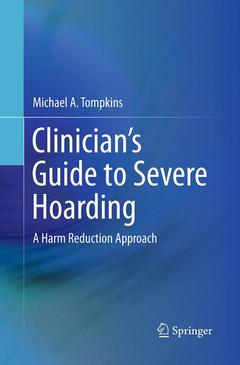Clinician's Guide to Severe Hoarding, Softcover reprint of the original 1st ed. 2015 A Harm Reduction Approach
Auteur : Tompkins Michael A.

The cat lady. The couple who won't let anyone in their apartment. The old man with all that junk in his yard. Their severe hoarding puts them, and often others, at risk for injury, disease, and even death. Most deny needing help, and for this reason, professionals are desperate to find more effective ways to offer and provide assistance to them.
In response to this growing public health problem, Clinician's Guide to Severe Hoarding refines our understanding and presents in depth and innovative alternative to traditional interventions. Arguing that although treatment for hoarding can be effective for those who are open to help, people with severe hoarding are not. The Clinician?s Guide to Severe Hoarding describes an alternative strategy to help those who adamantly refuse help and yet face significant health and safety risks due to the hoarding problem ? harm reduction. This client-centered approach takes readers through harm reduction plan development, team building, goal setting, client collaboration, and progress assessment. The Clinician?s Guide also explains that a successful harm reduction plan may encourage clients to seek further help, and offers insights into working with special populations such as people who hoard animals and children who exhibit hoarding behavior. The Clinician's Guide describes in detail a range of strategies for assisting people with severe hoarding:
- Strategies for engaging with clients who hoard.
- Guidelines for assessing harm potential.
- Guidelines for creating a harm reduction plan, building a harm reduction team, and conducting and evaluating home visits.
- Skills for client self-help: decision making, time management, and more.
- Guidelines for navigating the ethical and legal issues that arise in assisting people who hoard.
- Readings, links, and other resources.
With its practical common-sense approach to a complex problem, Clinician's Guide to Severe Hoarding is a unique volume not only for mental health practitioners, but also other professionals who assist people who hoard, such as home health aides, social workers, and professional organizers.
Michael A. Tompkins, Ph.D. is a licensed psychologist, a founding partner of the San Francisco Bay Area Center for Cognitive Therapy, Assistant Clinical Professor at the University of California, Berkeley, and a Founding Fellow of the Academy of Cognitive Therapy. Dr. Tompkins is the author or co-author of numerous articles and chapters on cognitive-behavior therapy and related topics, including a book and videotape series titled, Essential Components of Cognitive-Behavior Therapy for Depression (APA, 2001) and Therapy Homework: Key Steps to Creating and Implementing Successful Homework Assignments (Guildford Press, 2004). Currently, he is at work on a book titled, Cognitive-Behavior Therapy for Obsessive Compulsive Disorder in Youth: A Step-by-Step Guide to be published by the American Psychological Association. Dr. Tompkins has presented nationally on the topic of compulsive hoarding.
Focus will be specifically on the needs of family members or those close to persons who hoard rather than hoarders themselves
Present a unique approach to the problem of compulsive hoarding (harm reduction) which focuses on assisting family members in developing a plan to manage the problem
Raise awareness of a unique form of obsessive-compulsive behavior that has not been widely written about
Take the focus off discarding and put the focus on problem management leading to a less stressful healing process
Date de parution : 09-2016
Ouvrage de 413 p.
15.5x23.5 cm
Disponible chez l'éditeur (délai d'approvisionnement : 15 jours).
Prix indicatif 116,04 €
Ajouter au panierDate de parution : 11-2014
Ouvrage de 413 p.
15.5x23.5 cm
Disponible chez l'éditeur (délai d'approvisionnement : 15 jours).
Prix indicatif 158,24 €
Ajouter au panierThèmes de Clinician's Guide to Severe Hoarding :
Mots-clés :
animal hoarding; children and hoarding behavior; cleanout intervention; compulsive hoarding; elders and hoarding; harm potential; harm potential assessment; harm reduction; harm reduction agreement; harm reduction approach; harm reduction monitoring plan; harm reduction plan; harm reduction process; harm reduction targets; hoarding behavior; hoarding disorder; hoarding task force; severe hoarding



